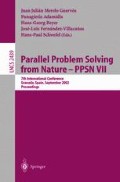Abstract
We consider the problem of estimating the evolutionary history of a collection of organisms in terms of a phylogenetic tree. This is a hard combinatorial optimization problem for which different EA approaches are proposed and evaluated. Using two problem instances of di.erent sizes, it is shown that an EA that directly encodes trees and uses ad-hoc operators performs better than several decoder-based EAs, but does not scale well with the problem size. A greedy-decoder EA provides the overall best results, achieving near 100%-success at a lower computational cost than the remaining approaches.
Access this chapter
Tax calculation will be finalised at checkout
Purchases are for personal use only
Preview
Unable to display preview. Download preview PDF.
References
Y. Cao, N. Okada, and M. Hasegawa. Phylogenetic position of guinea pigs revisited. Molecular Biology and Evolution, 14(4):461–464, 1997.
X. Chen, S. Kwong, and M. Li. A compression algorithm for DNA sequences and its application in genome comparisons. Genome Informatics, 10:51–61, 1999.
C. Cotta and J.M. Troya. Genetic forma recombination in permutation flowshop problems. Evolutionary Computation, 6(1):25–44, 1998.
J. Hein. A new method that simultaneously aligns and reconstructs ancestral sequences for any number of homologous sequences, when the phylogeny is given. Molecular Biology and Evolution, 6:649–668, 1989.
S. Holmes. Phylogenies: An overview. In Halloran and Geisser, editors, Statistics and Genetics, pages 81–119. Springer-Verlag, New York NY, 1999.
D. Huson, S. Nettles, and T. Warnow. Disk-covering, a fast converging method for phylogenetic tree reconstruction. Journal of Computational Biology, 6(3):369–386, 1999.
S Koziel and Z. Michalewicz. A decoder-based evolutionary algorithm for constrained parameter optimization problems. In T. Bäeck, A.E. Eiben, M. Schoenauer, and H.-P. Schwefel, editors, Parallel Problem Solving from Nature V-LNCS 1498, pages 231–240. Springer-Verlag, Berlin Heidelberg, 1998.
H. Matsuda. Protein phylogenetic inference using maximum likelihood with a genetic algorithm. In Proceedings of the Pacific Symposium on Biocomputing, pages 512–523. World Scientific, 1996.
Z. Michalewicz. Genetic Algorithms + Data Structures = Evolution Programs. Springer-Verlag, Berlin, 1992.
A. Moilanen. Searching for the most parsimonious trees with simulated evolution. Cladistics, 15:39–50, 1999.
C.-K. Ong, S. Nee, A. Rambaut, H.-U. Bernard, and P.H. Harvey. Elucidating the population histories and transmission dynamics of papillomaviruses using phylogenetic trees. Journal of Molecular Evolution, 44:199–206, 1997.
N.J. Radcliffe. Equivalence class analysis of genetic algorithms. Complex Systems, 5:183–205, 1991.
A. Reyes, C. Gissi, G. Pesole, F.M. Catzeflis, and C. Saccone. Where do rodents fit? Evidence from the complete genome of Sciurus vulgaris. Molecular Biology and Evolution, 17(6):979–983, 2000.
Bang Ye Wu, Kun-Mao Chao, and Chuan Yi Tang. Approximation and exact algorithms for constructing minimum ultrametric trees from distance matrices. Journal of Combinatorial Optimization, 3(2):199–211, 1999.
Author information
Authors and Affiliations
Editor information
Editors and Affiliations
Rights and permissions
Copyright information
© 2002 Springer-Verlag Berlin Heidelberg
About this paper
Cite this paper
Cotta, C., Moscato, P. (2002). Inferring Phylogenetic Trees Using Evolutionary Algorithms. In: Guervós, J.J.M., Adamidis, P., Beyer, HG., Schwefel, HP., Fernández-Villacañas, JL. (eds) Parallel Problem Solving from Nature — PPSN VII. PPSN 2002. Lecture Notes in Computer Science, vol 2439. Springer, Berlin, Heidelberg. https://doi.org/10.1007/3-540-45712-7_69
Download citation
DOI: https://doi.org/10.1007/3-540-45712-7_69
Published:
Publisher Name: Springer, Berlin, Heidelberg
Print ISBN: 978-3-540-44139-7
Online ISBN: 978-3-540-45712-1
eBook Packages: Springer Book Archive

